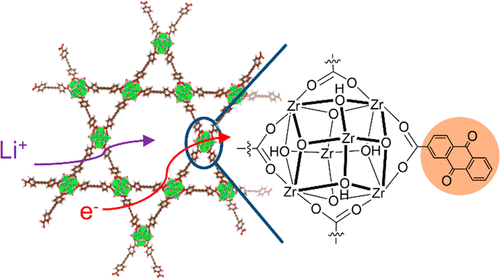当前位置:
X-MOL 学术
›
Chem. Mater.
›
论文详情
Our official English website, www.x-mol.net, welcomes your
feedback! (Note: you will need to create a separate account there.)
Improving Charge Transfer in Metal–Organic Frameworks through Open Site Functionalization and Porosity Selection for Li–S Batteries
Chemistry of Materials ( IF 7.2 ) Pub Date : 2020-09-04 , DOI: 10.1021/acs.chemmater.0c02438 Bingqian Liu 1 , V. Sara Thoi 1, 2
Chemistry of Materials ( IF 7.2 ) Pub Date : 2020-09-04 , DOI: 10.1021/acs.chemmater.0c02438 Bingqian Liu 1 , V. Sara Thoi 1, 2
Affiliation

|
The tunable nature of metal–organic frameworks (MOFs) enables versatility and precise control over structures and properties, making them feasible for potential applications including gas storage and separation, catalysis, molecular sensing, and energy storage. However, porous MOFs are typically insulating, greatly limiting their utility in electrochemical devices. Introducing redox activity to MOFs can promote charge conduction and provide insights into redox mechanisms in a multidimensional coordination system. Toward this end, we prepared a series of anthraquinone (AQ)-functionalized zirconium MOFs (MOF-AQ) to investigate the relationship between porosity and charge transfer reactions using the canonical MOF-808 and NU-1000 frameworks. We evaluated the ability of these frameworks as sulfur host materials to promote polysulfide redox, which are critical conversions for Li–S batteries. Li–S batteries are promising contenders as high-capacity energy storage devices, with an energy density surpassing that of Li ion batteries. We found that the incorporation of AQ on the nodal structure leads to improvement in specific capacity, particularly at high charge and discharge rates. More importantly, enhanced electrochemical behavior of NU-1000-AQ over MOF-808-AQ suggests that larger pore aperture favors overall charge transfer and diffusion. Our study demonstrates there is a delicate balance between AQ loading and available pore volume for ion flux to achieve optimized charge transfer efficiency under fast charge–discharge conditions. Our work provides insight for future designs of novel redox-active MOFs to facilitate charge transport in porous coordination networks.
中文翻译:

通过开放站点功能化和Li-S电池的孔隙率选择来改善金属有机框架中的电荷转移
金属-有机框架(MOF)的可调性使多功能性和对结构和性能的精确控制成为可能,可用于包括气体存储和分离,催化,分子传感和能量存储在内的潜在应用。但是,多孔MOF通常是绝缘的,大大限制了它们在电化学装置中的实用性。向MOF引入氧化还原活性可以促进电荷传导,并提供多维协调系统中氧化还原机制的见解。为此,我们使用规范的MOF-808和NU-1000框架制备了一系列蒽醌(AQ)功能化的锆MOF(MOF-AQ),以研究孔隙度与电荷转移反应之间的关系。我们评估了这些框架作为硫基质材料促进多硫化物氧化还原的能力,对于锂电池来说,这是至关重要的转换。Li-S电池作为高容量的能量存储设备,有望成为竞争者,其能量密度超过Li离子电池。我们发现,在节点结构上引入AQ可以提高比容量,特别是在高充放电速率下。更重要的是,NU-1000-AQ的电化学行为优于MOF-808-AQ,这表明较大的孔径有利于总体电荷转移和扩散。我们的研究表明,在快速充放电条件下,AQ负载和离子通量的可用孔体积之间存在微妙的平衡,以实现最佳的电荷转移效率。我们的工作为新型氧化还原活性MOF的未来设计提供了见识,以促进多孔配位网络中的电荷传输。
更新日期:2020-10-13
中文翻译:

通过开放站点功能化和Li-S电池的孔隙率选择来改善金属有机框架中的电荷转移
金属-有机框架(MOF)的可调性使多功能性和对结构和性能的精确控制成为可能,可用于包括气体存储和分离,催化,分子传感和能量存储在内的潜在应用。但是,多孔MOF通常是绝缘的,大大限制了它们在电化学装置中的实用性。向MOF引入氧化还原活性可以促进电荷传导,并提供多维协调系统中氧化还原机制的见解。为此,我们使用规范的MOF-808和NU-1000框架制备了一系列蒽醌(AQ)功能化的锆MOF(MOF-AQ),以研究孔隙度与电荷转移反应之间的关系。我们评估了这些框架作为硫基质材料促进多硫化物氧化还原的能力,对于锂电池来说,这是至关重要的转换。Li-S电池作为高容量的能量存储设备,有望成为竞争者,其能量密度超过Li离子电池。我们发现,在节点结构上引入AQ可以提高比容量,特别是在高充放电速率下。更重要的是,NU-1000-AQ的电化学行为优于MOF-808-AQ,这表明较大的孔径有利于总体电荷转移和扩散。我们的研究表明,在快速充放电条件下,AQ负载和离子通量的可用孔体积之间存在微妙的平衡,以实现最佳的电荷转移效率。我们的工作为新型氧化还原活性MOF的未来设计提供了见识,以促进多孔配位网络中的电荷传输。











































 京公网安备 11010802027423号
京公网安备 11010802027423号